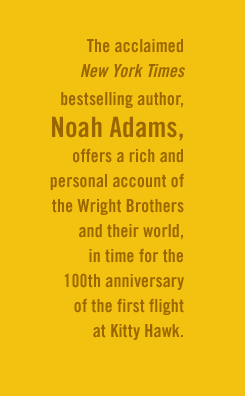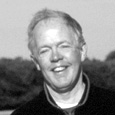| 1.
What drew you to this story?
At Kitty Hawk, in the late fall of 2001, I walked the actual path
of the first flight. It took only nineteen seconds to walk, twelve
seconds for Orville Wright to fly. There were no planes in the air,
anywhere in the world before that moment on December 17, 1903, and
I remembered hearing that on the morning of September 11 four thousand
planes were in the air above America. For me, the landscape of the
Outer Banks held the drama of that evolution. Why did it all start
here? Why these two young men from Dayton?
I realized my great-grandfather might have met the Wright brothers
and might even have been tempted to help with their flying experiments.
He was Haskell Wellman, 34 years old in 1900, an inventor and mechinist
living in our small Ohio River town of Ashland, Kentucky. As I was
to learn, the train that took the Wrights to North Carolina made
a regular stop in Ashland. Haskell could have met the brothers,
talked shop, even talked airplanes, but an adventure with the flying
machines would have been out of the question for my great-grandfather,
who had a business to look after and a family, which included my
namesake Noah, then four years old. The Wrights, however, were not
married and still lived at home, earning a fair amount from their
bicycle business. They were perfectly positioned to invent the airplane.
They had lots of time, superb mechanical skills, and vivid technical
imaginations., plus the courage to make thousands of risky flights.
Until the Wrights, no one one knew how to design planes and no one
knew how to fly them.
That morning, standing on the sandy path at Kill Devil Hills at
the Wright Brothers National Memorial, I knew none of this. Brothers
from Dayton, yes. Bicycle makers, yes. But where did this curiosity
and drive and talent come from, and what happened after the first
flights? I decided to follow the story of Wilbur and Orville by
traveling to the places where it unfolded. It would be a way to
better imagine the moments of discovery and joy, as well as the
fear and despair.
2. What
was it like to be in the same places where Wilbur and Orville flew?
Aside from the Outer Banks, my first trip was France, where Wilbur
traveled in 1907 and where he first flew in public in 1908. He shocked
the European aviators with his beautifully controlled flying at
a horse-racing track outside Le Mans. I took a taxi out into the
countryside, not knowing if the track still existed. But there it
was, a dirt oval with a wooden grandstand, and you could close your
eyes and hear the motor start up and the gasp of the crowd when
Wilbur made his first banked turn. Governors Island in New York
Harbor has always been private property and rarely visited, but
I took a ferry ride across from Lower Manhattan and tried to envision
Wilbur’s flights from the gravelly field, out around the Statue
of Liberty, then ten miles up the Hudson River to Grant’s
Tomb. New Yorkers watched from below, seeing an airplane for the
first time. I also spent several days at Huffman Prairie, now a
part of Wright-Patterson Air Force Base, outside Dayton. It looks
much the same as when the brothers began flying there in 1904, working
to perfect their design. World War I aviators were later trained
at Huffman Prairie—it’s truly America’s first
airfield.
The Wrights’ home, Hawthorn Hill, was fascinating, lovely
and echoing with history. Charles Lindbergh was among the many aviation
pioneers who came to dinner there. I chose to begin my story where
the Wrights are buried. Dayton’s Woodland Cemetery is a splendid
expanse of lawn and trees where the Wright family has a modest hillside
plot among those of their neighbors and colleagues from Dayton’s
golden years of invention and manufacturing. I would walk along
the ridge in the evening, watching the wind toss up the leaves,
trying to understand the brothers’ fascination with flight,
and the earnest, stubborn drive that brought them success.
3. The
Flyers is rich with detail. How did you conduct your research?
I started by reading, over a period of several weeks, the wonderful
biographies of Wilbur and Orville, along with accounts of Dayton
at the turn of the last century, and novels of the era. Then it
was time to turn to the primary sources. My wife, Neenah Ellis,
and I spent the summer in Yellow Springs, Ohio, to be near the archives
at Wright State University. Every day I’d go in with a particular
subject in mind and end up deep in another, equally fascinating
area. An archivist would say, “Have you seen Orville’s
collection of calling cards that he saved from all the people who
came to visit?” Or a local expert would drop by and I’d
end up deep in the intricacies of the Wrights’ various motors.
Plus you have access to thousands of photographs and hundreds of
books, and—suspended from the ceiling—a full-size model
of the 1903 Flyer for inspiration.
Back home in Washington, D.C., I was just a quick subway ride away
from the National Air and Space Museum, where the real Flyer is
displayed, and the Library of Congress, where I was allowed a special
viewing of the glass negative of the first flight photograph and
spent long days reading through the brothers’ correspondence
and journals and notebooks. You can see Orville’s understated
account of his 1903 flight; if he was excited you can’t see
it on the page.
4. How
did you come across Orville’s fascinating relationship with
Katharine, his younger sister?
You have to read Katharine’s letters!” I kept hearing
this from people whose work I respected. I finally racked up the
spool of microfilm and began a journey deep into the private world
of Katharine Wright Haskell. She was extremely close to Orville,
lived with him at Hawthorn Hill (Wilbur died much earlier), and
when she fell in love late in life and married Orville felt betrayed,
as if Katharine had broken a vow. Katharine married at 52 and moved
to Kansas City. Orville did not attend the wedding and only saw
his sister when she was dying two years later. It’s truly
a family tragedy, and even more so because I think they would have
reconciled had she not died so soon. Katharine’s letters to
[Henry Haskell] have been saved, and we at least have the story
from her point of view. The letters are marvelous, and it’s
a great way to learn more about the relationships within the Wright
family, and especially about Orville’s determination.
5. How
do you think Wilbur and Orville Wright would view the armed forces’
dependence on aircraft to carry out military campaigns?
At first they didn’t seem to have thought much about what
an airplane might actually do. Remember, they took off at one spot
and return to land at the same place. The potential for military
scouting was clear because balloons had already been used for that
purpose, but the use of the airplane as an instrument of war was
a new concept. Orville wrote later: “The wildest stretch of
the imagination would not have permitted us to believe that thousands
of these machines would be used in deadly combat. We did not foresee
the extent to which the aeroplane might be used in carrying the
battle line into the industrial centers and into the midst of noncombatants,
though we did think it might be used in dropping an occasional bomb
about the heads of the rulers who declared war and stayed home.”
6. Was
there anything that surprised you about the story of the Wright
brothers?
I had vastly underestimated their technical and mechanical talent
and intelligence and imagination. They accomplished within a few
years and for a few thousand dollars a feat that today is supremely
difficult to duplicate, even for a million dollars—it’s
amazingly hard to build a working replica of their 1903 Flyer. I
was also surprised by the quality of their writing, their journal
entries, their letters, their technical articles, legal arguments.
It’s almost as if you could learn this story in reverse—read
the archival material back through the years and you’ll easily
understand how they could have invented the airplane. They believed
it was possible, and they believed they were the ones who would
do it. |






